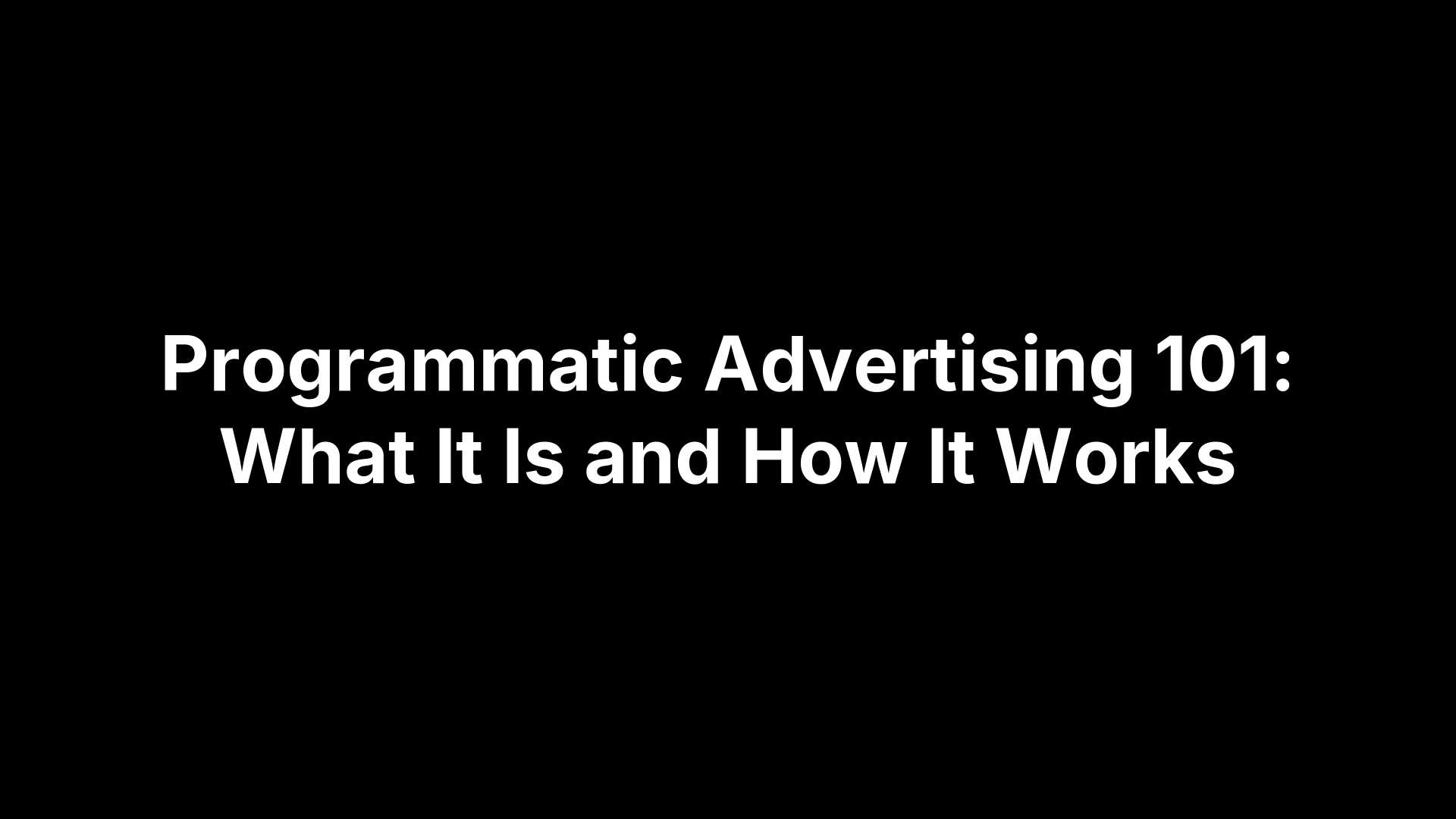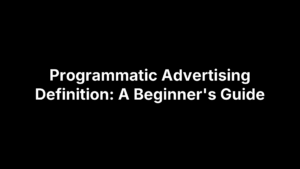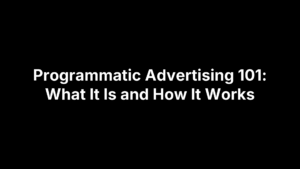Programmatic advertising is automated ad buying that uses software and artificial intelligence to purchase digital ad space in real time. Instead of manually negotiating with websites or calling media reps, you set your targeting parameters and budget, then let technology handle the rest. The system finds your ideal customers across thousands of websites, apps, and streaming platforms, bidding on ad placements in milliseconds. For flooring retailers, this means your ads reach people actively researching new floors, not just anyone browsing the internet.
This guide breaks down programmatic advertising for flooring store owners who want better results from their digital marketing. You’ll learn why this method works better than traditional display ads, how to implement it for your store, and what happens behind the scenes when someone sees your ad. We’ll cover the main types of programmatic ads you can run, show you real examples that work, and help you choose the right tools without getting lost in technical jargon. By the end, you’ll understand whether programmatic advertising fits your marketing strategy and how to get started.
Why programmatic advertising matters today
Traditional advertising methods waste your budget by showing ads to everyone, hoping a few interested buyers notice. Programmatic advertising changes this by targeting only people who show real purchase intent. Your flooring store competes for attention in a crowded market where 90% of consumers research online before visiting a store. You need a system that finds these active researchers and puts your business in front of them at the right moment.
The shift in consumer behavior
Your potential customers no longer flip through phone books or wait for Sunday newspaper ads. Digital channels now dominate the shopping journey, with buyers spending weeks researching flooring options on their phones, tablets, and computers before ever calling a store. They visit home improvement blogs, watch installation videos on streaming services, and compare products across multiple websites. Programmatic technology tracks these behaviors and identifies when someone moves from casual browsing to serious shopping mode.
Understanding what is programmatic advertising means recognizing that modern buyers leave digital footprints showing exactly when they’re ready to buy.
The cost advantage over traditional methods
Traditional display advertising charges you for impressions whether they reach interested buyers or not. You pay the same rate for someone browsing celebrity gossip as you do for someone actively planning a kitchen remodel. Programmatic platforms use real-time bidding to adjust your spending based on audience quality, paying more for high-intent shoppers and less for casual browsers. This efficiency means your advertising budget works harder, reaching 10 times more qualified prospects than blanket campaigns. Flooring retailers who switch to programmatic typically see 30-50% better conversion rates while reducing their overall ad spending.
How to use programmatic advertising in your store
Starting with programmatic advertising requires three core elements: clear campaign goals, defined audience targets, and compelling creative assets. You don’t need technical expertise to launch your first campaign, but you do need a strategic approach that connects your inventory to active buyers in your market. Flooring retailers succeed with programmatic when they focus on local reach and buyer intent signals rather than casting a wide national net. Your store competes best when you target homeowners within your service area who demonstrate real shopping behavior.
Define your campaign goals and budget
Campaign objectives determine everything else in your programmatic strategy, from the platforms you use to how you measure success. You might want to increase phone calls from qualified buyers, drive foot traffic to your showroom, or build awareness for a new product line. Each goal requires different tactics: call campaigns need click-to-call mobile ads, showroom visits benefit from geo-targeted display ads, and brand awareness works through video on streaming platforms. Start with one primary objective rather than trying to accomplish everything at once.
Budget allocation follows your goals and market size. Most flooring stores see results with $2,000 to $5,000 monthly spend in programmatic, though smaller markets can start at $1,000 and larger metro areas may need $10,000 or more for significant impact. Your budget determines how many qualified impressions you can afford, with higher bids winning premium placements in front of active shoppers. Set aside 20% of your total budget for testing different creative approaches and audience segments during your first 90 days.
Build audience segments based on buyer behavior
Understanding what is programmatic advertising means recognizing that audience targeting separates successful campaigns from wasted spending. You create segments based on behavioral signals that indicate purchase readiness: visiting flooring product pages, watching installation videos, searching for local installers, or spending time on home renovation content. Your programmatic platform tracks these behaviors across millions of websites and apps, building profiles of people who match your ideal customer.
Flooring purchase journeys typically span 30 to 90 days from initial research to final purchase, giving you multiple touchpoints to reach the same buyer. You should target three distinct audience types. Planners are 3-6 months out from purchase, researching options and gathering ideas. Researchers are actively comparing products, reading reviews, and learning about installation. Shoppers are visiting stores (including competitors) and ready to make decisions. Each segment needs different messaging that matches their current mindset.
Your programmatic ads work best when you match the message to where buyers are in their journey, not just showing the same generic ad to everyone.
Create location-specific campaigns
Geographic targeting ensures your ads reach only people who can actually visit your store or live within your installation service area. You set radius boundaries around your location, typically 15 to 30 miles for suburban stores and 5 to 10 miles for urban shops. Programmatic platforms let you exclude areas you don’t service, preventing wasted impressions on people too far away. You can also increase bids for premium ZIP codes where homeowners have higher purchasing power and larger renovation budgets.
Localization extends beyond targeting to your ad creative and landing pages. Feature your actual showroom in photos, mention your city or neighborhood by name, and highlight local installation teams. Store-specific promotions perform better than generic manufacturer rebates because they create urgency and demonstrate you’re a real business in their community, not just another online retailer.
How programmatic advertising works behind the scenes
Real-time auctions happen in the 300 milliseconds between when someone clicks a website link and when the page fully loads on their screen. Your programmatic system evaluates that visitor, checks if they match your target audience, calculates a bid based on their value to your business, and competes against other advertisers for that ad placement. All of this occurs automatically without human intervention, processing millions of data points to decide if this person is worth showing your flooring ad. The technology handles everything from audience matching to creative selection to final delivery, giving you results without constant manual oversight.
The real-time bidding process
Each ad impression goes through an instantaneous auction that determines which advertiser wins the placement. When someone visits a website or opens an app, the publisher’s system sends out a bid request containing information about the visitor and the available ad space. Your demand-side platform (DSP) receives this request, analyzes whether the visitor matches your target audience, and submits a bid within milliseconds. The highest bidder wins and their ad displays to the user, with the entire process finishing before the page finishes loading.
Bid amounts fluctuate based on audience quality and competition. You might bid $0.50 to reach someone who just searched for "luxury vinyl plank installation near me" but only $0.05 for someone casually browsing home decor content. The system optimizes automatically, learning which placements and audiences convert best for your store, then shifting more budget toward high-performing segments. This dynamic pricing means you pay fair market rates rather than fixed costs, investing more in quality traffic and less in marginal prospects.
Key platforms in the ecosystem
Three platform types work together to make programmatic advertising function smoothly. Demand-side platforms (DSPs) are where you set up campaigns, define audiences, and manage budgets. Supply-side platforms (SSPs) represent publishers who have ad space to sell across their websites, apps, and streaming channels. Ad exchanges connect DSPs and SSPs, creating the marketplace where real-time bidding happens. You interact primarily with your DSP while the other platforms operate in the background, automatically finding inventory that matches your targeting criteria.
Understanding what is programmatic advertising requires recognizing that these platforms communicate instantly, evaluating every impression opportunity to determine if it’s worth bidding on for your specific campaign.
Data signals that trigger your ads
Behavioral data drives programmatic targeting, tracking what people do online to identify purchase intent. The system monitors website visits, search queries, content consumption, and time spent on specific topics to build profiles of active shoppers. For flooring campaigns, relevant signals include visiting product comparison sites, watching installation tutorials, reading renovation blogs, searching for local contractors, and spending repeated sessions on flooring content. Multiple signals together create stronger intent indicators than any single action alone.
Cookie technology and device IDs enable platforms to recognize the same person across different websites and devices. When someone researches hardwood flooring on their work computer, then browses laminate options on their phone during lunch, programmatic systems connect these sessions to the same individual. This cross-device tracking lets you reach buyers throughout their entire journey, serving consistent messaging whether they’re on mobile, desktop, tablet, or connected TV.
Key types and examples of programmatic ads
Four main ad formats dominate programmatic campaigns for flooring retailers, each serving different purposes in your customer acquisition strategy. Display banners appear on websites and apps, video ads run before streaming content, native ads blend into editorial feeds, and connected TV commercials reach viewers on smart TVs and streaming devices. Your choice depends on where your target customers spend time and what message you need to deliver, with most successful campaigns using multiple formats to cover the entire buyer journey.
Display banner ads across websites
Standard display banners remain the workhorse of programmatic advertising, showing your flooring products on thousands of websites that active shoppers visit. These rectangular ads appear in various sizes, from small mobile banners to large desktop leaderboards, adapting automatically to fit different screen sizes and placements. Your creative might feature a new waterproof vinyl collection with pricing, a limited-time installation discount, or before-and-after room transformations that demonstrate your work quality. Display ads work best for reaching researchers who spend time reading home improvement articles, browsing Pinterest boards, or comparing product reviews.
Display banners deliver consistent brand exposure as potential customers move across different websites during their research phase, keeping your store top-of-mind throughout their decision process.
Video ads on streaming platforms
Video advertising reaches your audience while they watch shows on streaming services like Hulu, YouTube, or local news apps on their connected TVs and mobile devices. Programmatic video placements let you run 15 to 30-second commercials that showcase your showroom, highlight installation craftsmanship, or explain product benefits that text and images can’t convey effectively. You target the same behavioral signals as display campaigns but deliver a more engaging format that captures attention during premium viewing moments. Flooring stores use video for high-value products like hardwood or luxury tile where visual demonstration drives purchase decisions.
Native ads that match content
Native advertising disguises promotional content to look like editorial articles or social media posts, appearing in news feeds and content recommendation widgets. Your flooring ad might display alongside home renovation tips or design inspiration, labeled as sponsored content but formatted to match the surrounding posts. These ads blend seamlessly into the user experience, generating higher engagement rates than traditional banners because they don’t interrupt the browsing flow. Native works particularly well for educational content like flooring comparison guides or maintenance tips that provide value while introducing your brand to new prospects.
Choosing tools for programmatic advertising
Platform selection determines your campaign success more than creative quality or budget size, yet most flooring retailers struggle to evaluate options without getting overwhelmed by technical features they’ll never use. You need systems that handle complex targeting automatically while giving you simple controls for budget, geography, and creative management. The right tool matches your technical comfort level, integrates with your existing marketing stack, and provides transparent reporting that shows exactly where your money goes. Understanding what is programmatic advertising includes recognizing that platforms vary dramatically in ease of use, with some designed for Fortune 500 companies with dedicated teams and others built for small business owners managing campaigns themselves.
Evaluating demand-side platforms
Self-service platforms like Google Display & Video 360 and Amazon DSP give you direct control over campaigns but require significant learning curves and ongoing optimization expertise. You set up audiences, create bidding strategies, and analyze performance data through complex dashboards designed for professional media buyers. These enterprise systems work well if you have marketing staff with programmatic experience or time to learn the platforms thoroughly, but they overwhelm most flooring store owners who need simpler solutions. Direct platform access typically requires minimum monthly spending of $10,000 or more, putting them out of reach for smaller operations.
Working with specialized agencies
Managed services handle programmatic campaigns on your behalf, combining platform access with human expertise to optimize performance without requiring your constant attention. You provide creative assets, budget parameters, and business goals, then the agency builds audiences, launches campaigns, and adjusts strategies based on results. Industry-specific agencies understand flooring buyer behavior and can target active shoppers more effectively than generalist firms that lack vertical expertise. This approach costs more than self-service platforms but delivers better results when you lack internal programmatic knowledge or time to manage campaigns daily.
Specialized agencies with flooring industry experience typically generate 40-60% better conversion rates than general digital marketing firms because they understand exactly which behavioral signals indicate real purchase intent.
Essential features to prioritize
Transparent reporting should show you exactly where ads appear, which audience segments perform best, and how much each lead or call costs your business. You need platforms that update metrics daily rather than monthly, letting you spot problems quickly and capitalize on winning combinations. Geographic precision matters enormously for flooring retailers since you only want to reach people within your service area, so prioritize tools that offer ZIP code level targeting and radius controls around your store location. Cross-device tracking ensures you reach the same buyer on mobile, desktop, and connected TV without wasting budget on duplicate impressions to people who already saw your message.
Final thoughts
Programmatic advertising transforms how flooring retailers reach active buyers by replacing guesswork with data-driven targeting and automated efficiency. You now understand what is programmatic advertising means in practice: technology that finds your ideal customers, delivers relevant messages at the right moments, and adjusts spending based on real-time performance. This approach eliminates the waste inherent in traditional advertising while increasing your connection with high-intent shoppers who actually need flooring solutions.
Your next step depends on whether you want to manage campaigns yourself or partner with specialists who understand flooring buyer behavior. Self-service platforms require significant time investment and technical learning, while managed services deliver results without demanding your constant attention. Most flooring stores succeed faster with industry-specific expertise that targets planners, researchers, and shoppers using proven behavioral signals.
IFDA.ai built its entire business around programmatic advertising for flooring retailers, combining 25 years of industry knowledge with proprietary AI targeting models. Learn how our technology identifies active flooring buyers in your market and delivers your message when they’re ready to purchase.



